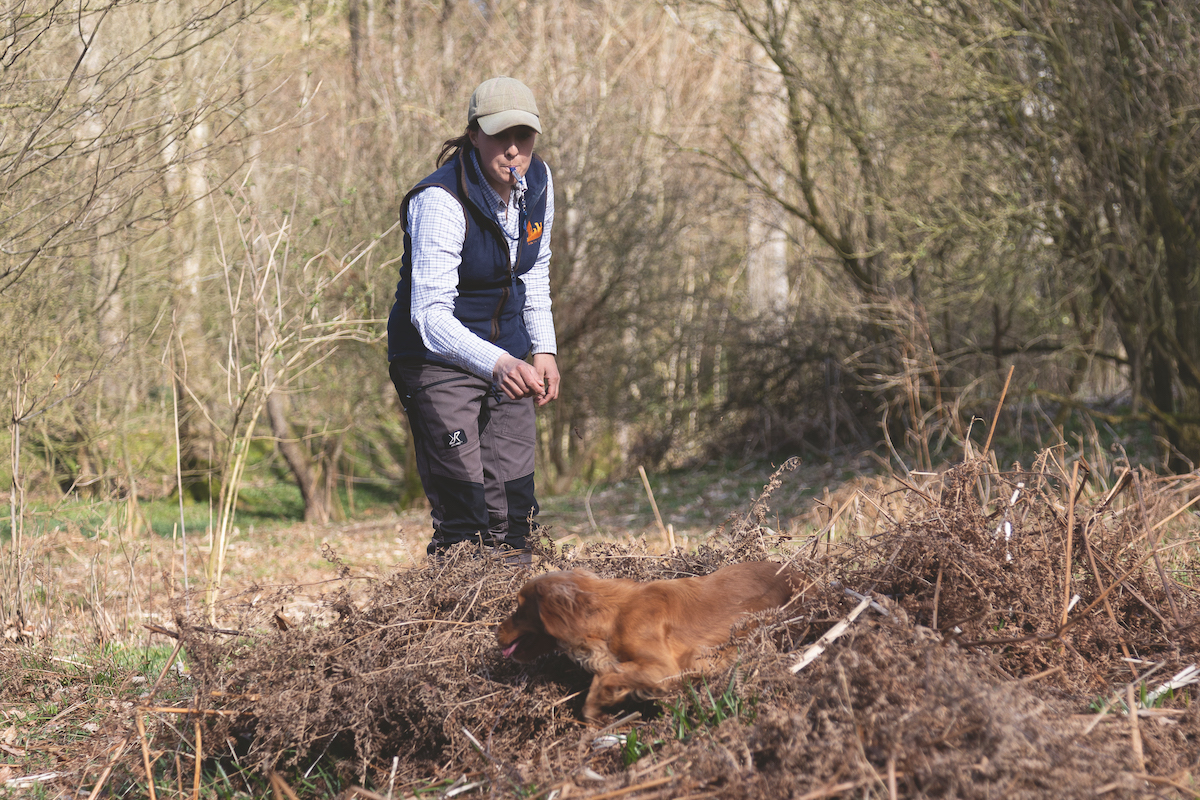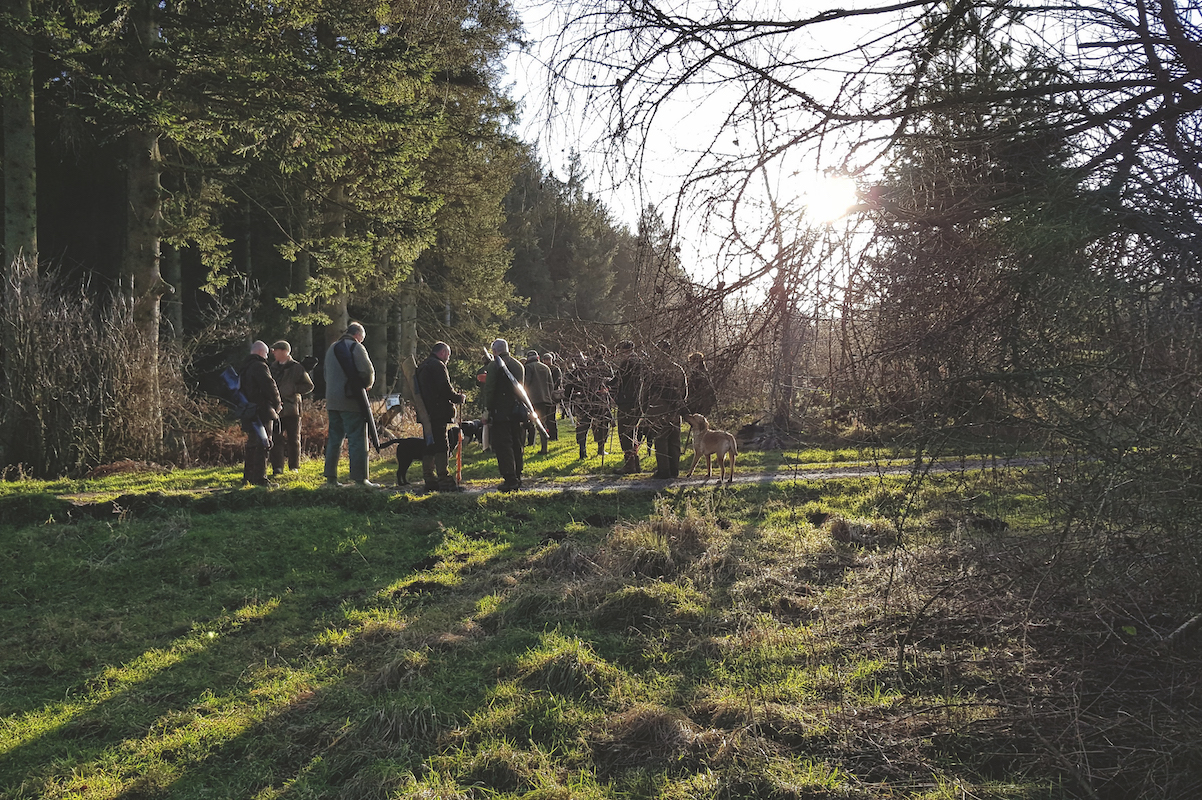How to train your gundog to hold a line
In the field, your dog will encounter all sort of terrain and obstacles, and ensuring it holds a line can be challenging, says Ellena Swift in Shooting Times
At a recent gundog training session, all of my dogs were running well, handling and stopping, hunting hard and generally being very pleasing. However, the ground was a little different to what they’re used to. The ground I was on was much more unforgiving. It had small gullies, ditches and banks, which made straightforward lines extremely difficult. An easy marked or memory retrieve was not as simple as I first thought. So it was time for training a gundog to hold a line.

With the dogs at heel, Ellena walks around the grass field, which features a thin hedge, two gullies and some soft rushes
Training a gundog to hold a line
The way the ground fell meant the dogs were being pulled left and right.
As I sent them each time, they were veering and running with the way the ground fell. For a shorter retrieve, this was not usually an issue as they were not too far from it once they got the distance. However, as soon as there was more distance involved, by the time the dog got level with the retrieve, it was at least 50 yards out one side or the other. This meant I was having to handle to get them in the area.
Wounded bird
Many may argue this does not matter on a shoot day. For some retrieves when sending your dog from the peg or even picking up, perhaps it doesn’t. But there are many occasions when it would. For example, if there are a lot of birds down and one is sitting up wounded. This should be the bird picked first. So it’s worthwhile training a gundog to hold a line. A bad line would make for a lot of handling and hard work when other game is around. It would be a lot simpler if, when the ground dips and falls, the dog will confidently hold its line and fight the ground rather than run with the challenging topography. I intend to compete. A dog that can fight the ground and get to the retrieve in one cast, as opposed to constant handling or interference, will always score better. It is more efficient, in every way in terms of the time and energy expended as well as from a welfare point in regards to the wounded bird.
It wasn’t until someone pointed out the subtle difference that I realised perhaps I had been settling for an average retrieve when I should be pushing for an excellent, if not perfect retrieve. All our working dogs are a product of the training we have done with them. A certain percentage comes down to their breeding, but a much larger proportion is as a result of the training and is down to us.

Use an electric pole to mark them.
Step by step guide to training a gundog to hold a line
Setting up
First of all, I find some areas that contain dips, banks and general topography that will throw them. The exercises to help them are all relatively simple. The last thing I want to do is knock a dog’s confidence, so it is important I keep them running with confidence. In the same breath, I need to ensure I do not except sub-par lines.
I take a walk around the area of ground with the dogs to heel. There is a thin hedge, two gullies and soft rushes. It is in a bowl, so no matter which way I cast, the dogs will be fighting the hills and cover. I walk to three areas and use an electric pole to mark them, purely as a guide for me, so when I am lining them up I know exactly where I am sending them.

You can teach a puppy or young dog how to ‘leave’ by using food bowls, one full and one empty
Making it harder
I put retrieves out in three different areas. It is really important that, first, the dogs see all of them, so they have the confidence to power out each time and will be more willing to fight the ground. But it is also important that the dogs are at a level at which they will not swap retrieves, because I am leaving two retrieves per dog in each area.
They are not simply running the line they have walked; the retrieves are harder than a basic simple mark. I have two dogs out with me doing this exercise. It is a good idea to have at least two or train with a friend when doing this. These are hard work and it is good for the dog to have a few minutes between each one to rest.
Make sure each dog goes to a different area from the one before. Many dogs are ‘monkey see, monkey do’ and will happily follow the line of the previous dog. Some handlers will line their dog on the retrieve they do not want and tell the dog “Leave!” then they line them up to the retrieve to cast them. This means they understand they are not required to pick ‘that one’.

Make sure each dog goes to a different area than the one before.
This is personal preference and there is no right or wrong way if it works for your dog. I have never introduced this to mine but I can see the benefits. Whichever you choose, make sure you remain consistent and start with simple exercises so the dog truly understands ‘leave’.
With a puppy or young dog, you can begin by using two feed bowls. Only put food in one; the dog will not know which. Put them approximately 10ft apart. Point to the empty bowl and say “Leave”. Then turn the dog and point to the full bowl and send them. They are rewarded by getting the bowl with their dinner. If they attempt to go to the empty one, quickly pick up the full one and start again. They will receive no reward as the bowl is empty.
They will quickly learn that ‘leave’ means no reward if you go to that one and to follow the line you are sending them on.

If a dog takes the wrong line, stop them as soon as you can
Correcting mistakes
Before I cast I look at the ground and pick the line I want the dog to run. Where the first dip is, rather than looking at the area marker, I look at where I want the dog to enter the first gully. It is a lot easier to aim a dog at this rather than the final area. In my head, I can see if the dog exits the gully on the same line as the one on which it entered; it will still be on a very good line to come across the retrieves.
Most of the retrieves the dogs cope will well, though one or two may struggle. They have to skim the top of the gully, run diagonally up a bank and ignore cover either side. If they veer even slightly, I lose sight of them and they lose their way.

When a dog makes a mistake an immediate correction will let him know he’s gone wrong; it is not a punishment and he gets praised for listening to Ellena before being sent out again
It went wrong with both dogs. Both the dogs I was running that day are slightly different personalities. One is much softer and sensitive, whereas Keepa is more confident and handles pressure much better. As soon as he gets his line wrong I shout “No”. He immediately knows he has made a mistake and this encourages him to come back.
This isn’t to punish him – the dog must be praised for listening and not worried about returning to start again. The timing of the interruption must be where the dog went wrong, not 20 yards beyond or they will not know or get confused which bit was wrong. Your message must be clear when training a gundog to hold a line The second time Keepa holds his line.
Ending on high note
With the second more sensitive dog, I break the retrieve down. I walk her to where her line went wrong and send her from there. Once she has achieved that, I move further and send again. I do this until I am where I started from. It is important you understand and know your dog’s individual temperament so you can approach them to get best out of them.
As I have left several retrieves out at each area, I can send both of them twice for each retrieve, hopefully ensuring they end on a successful high note. Later in the week I am going to do the same exercise with the same areas, but send from a different place. Keeping the same areas means they keep their confidence. Trainers have a tendency to overdo the blind retrieves and this ends up with one of two results depending on the dog’s temperament. They either flatten and become unsure/sticky. Or they decide to go ‘self-employed’ and stop listening and believing. Get to know your dog and its nature. This will tell you how you should approach potential issues and get the best out of your dog.








